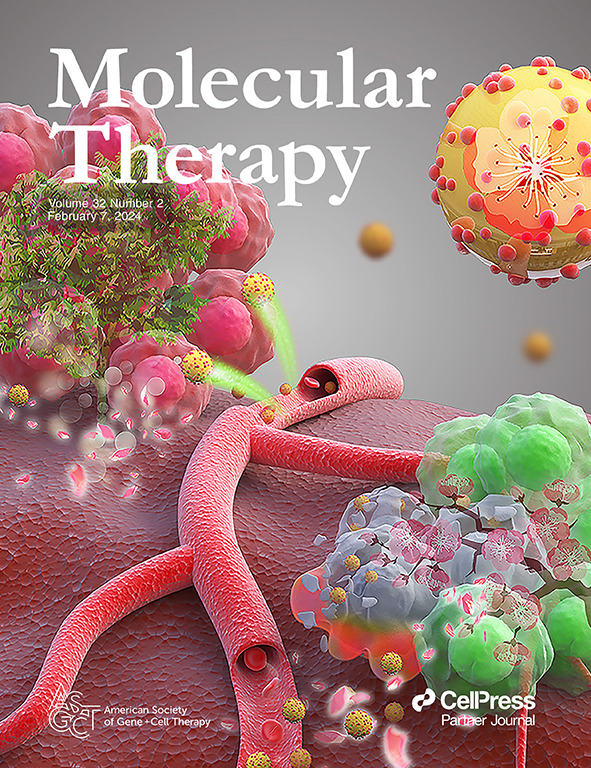fordadistrogene movaparvovec基因治疗杜氏肌营养不良的心脏安全性:来自1b期试验的初步观察
IF 12
1区 医学
Q1 BIOTECHNOLOGY & APPLIED MICROBIOLOGY
引用次数: 0
摘要
福达破露基因;PF-06939926)是一种含有微型肌营养不良蛋白转基因的重组腺相关病毒血清型9基因替代构建体,正在开发用于治疗杜氏肌营养不良症(DMD)。我们在一项正在进行的1b期、多中心、单臂、开放标签的低剂量和高剂量FM试验中,对DMD参与者进行了为期1年的随访,得出了心脏安全性评估的结果。从19名流动参与者(n=3,低剂量;n = 16,高剂量;中位年龄8.8岁)和3名非流动参与者(高剂量;中位年龄15.1岁)。6名门诊和3名非门诊参与者的ctn - 1水平在基线时高于正常上限(ULN)。其中,1名门诊参与者和2名非门诊参与者在输注后第一年的ctn - 1水平为基线水平的3倍。输注后1年,左室射血分数(LVEF)与基线相比的平均(±SD)变化在门诊参与者中为-0.9%±4.0%,在非门诊参与者中为- 3.1%±1.8%。一名16岁的非活动DMD参与者在高剂量FM治疗后6天出现致命性心源性休克。除了伴有晚期心脏纤维化的DMD参与者外,cMRI对ctn - 1、LVEF的评估以及晚期钆增强的进展表明,FM对动态DMD参与者的心脏毒性较低。本文章由计算机程序翻译,如有差异,请以英文原文为准。
Cardiac safety of fordadistrogene movaparvovec gene therapy in Duchenne muscular dystrophy: Initial observations from a phase 1b trial
Fordadistrogene movaparvovec (FM; PF-06939926) is a recombinant adeno-associated virus serotype-9 gene-replacement construct containing a mini-dystrophin transgene, in development for Duchenne muscular dystrophy (DMD). We present findings of cardiac safety assessments in DMD participants during a 1-year follow-up from an ongoing, phase 1b, multicenter, single-arm, open-label trial of low- and high-dose FM. Cardiac troponin-I (cTn-I) levels and cardiac magnetic resonance imaging (cMRI) measures were obtained from 19 ambulatory participants (n=3, low-dose; n=16, high-dose; median age 8.8 years), and three non-ambulatory participants (high-dose; median age 15.1 years). Six ambulatory and three non-ambulatory participants had cTn-I levels above the upper limit of normal (ULN) at baseline. Of these, one ambulatory participant and two non-ambulatory participants had cTn-I levels >3x the baseline level during the first year following infusion. At 1-year post-infusion, mean (±SD) change from baseline in left ventricular ejection fraction (LVEF) was -0.9%±4.0% in ambulatory participants, and −3.1%±1.8% in non-ambulatory participants. One 16-year-old non-ambulatory DMD participant experienced fatal cardiogenic shock 6 days after high-dose of FM. With the exception of participants with DMD with advanced cardiac fibrosis, assessments of cTn-I, LVEF by cMRI, and progression of late gadolinium enhancement suggest low cardiac toxicity from FM in ambulatory DMD participants in this study.
求助全文
通过发布文献求助,成功后即可免费获取论文全文。
去求助
来源期刊

Molecular Therapy
医学-生物工程与应用微生物
CiteScore
19.20
自引率
3.20%
发文量
357
审稿时长
3 months
期刊介绍:
Molecular Therapy is the leading journal for research in gene transfer, vector development, stem cell manipulation, and therapeutic interventions. It covers a broad spectrum of topics including genetic and acquired disease correction, vaccine development, pre-clinical validation, safety/efficacy studies, and clinical trials. With a focus on advancing genetics, medicine, and biotechnology, Molecular Therapy publishes peer-reviewed research, reviews, and commentaries to showcase the latest advancements in the field. With an impressive impact factor of 12.4 in 2022, it continues to attract top-tier contributions.
 求助内容:
求助内容: 应助结果提醒方式:
应助结果提醒方式:


